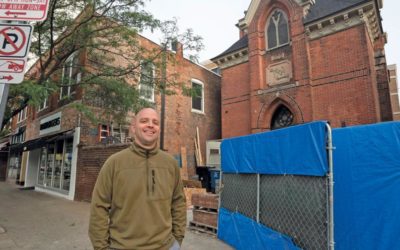Soybeans grew last summer in the fields of the three Nixon properties on the city’s far north side. Deer grazed in the woods, and frogs croaked in the wetlands.
In February, the fields, woods, and wetlands lay beneath a blanket of snow. But the land on Nixon Rd. won’t be pastoral much longer. Developers have plans to build 756 apartments, townhouses, and carriage houses there.
The three parcels–forty acres on the southwest corner of Nixon and Dhu Varren roads, sixty acres on the northwest corner, and fifty-four acres east of Nixon next to the Barclay Park condos–were owned by the late Don Nixon and his sister Betty Nixon Spurway. They had them on the market for twenty years, because they were very particular about selling the last pieces of what was once their family’s farm.
“They’re the best parcels left in southeast Michigan,” Don Nixon told the Observer before he died in July 2013. “They’re near North Campus and not far from town and have Ann Arbor schools. There’s frontage on Nixon and Dhu Varren, and they have all the utilities at the property line.”
Asked what he wanted for the parcels, the ninety-five-year-old Nixon laughed over the phone from Glacier Hills Manor. “That’s privileged information. At my age I want cash at the closing. I don’t want to put any land contract on it.
“Some people say I ought to put higher prices on it,” the former Detroit Realtor continued. “But I’ll be satisfied to get an ethical developer who wants to put up something nice.”
Nixon sold the east parcel and made arrangements to sell the others before he died. Barring another real estate crash, by the end of the decade the town’s biggest remaining block of undeveloped land will be gone.
—
The Nixon family first bought land in the area in the 1860s, but the property only reached its full form fifty years later. “My father, Lewis Nixon, assembled it in 1909,” Nixon explained. “He didn’t do it all at once, and I filled it in a little bit after he died.”
When he was growing up, Nixon recalled, Plymouth Rd. “was all vacant land with just a couple of houses. There were no shopping centers or anything else. The whole Pfizer complex and all of the North Campus were just vacant land. But it was always pretty land, and it was simple in those days to walk or take a bicycle downtown.”
Both Don and Betty graduated from the U-M, and both led urban lives–Don in Grosse Pointe, Betty in Chicago, where her late husband, Harold Spurway, ran the Carson Pirie Scott stores. But though they let other people farm it, they held onto the land. “We always owned it and never owed a dime on it in our lives,” Don said. “My father kept the title clean, and so did we.”
Now title to the property east of Nixon has passed, and the others will soon. “Adam Bleznak, who owns Woodbury Gardens [apartments off South Industrial], bought the fifty-four-acre site outright,” says city planner Alexis DiLeo. The north and south sites are under contract to Toll Brothers.
Adam Bleznak’s family company paid $1.5 million for the east parcel and plans to build a 283-unit rental complex called Woodbury Club there. “With all costs for land and fees totaled,” Bleznak says, each unit will cost about $125,000 to build. He expects a 1,000-square-foot, two-bedroom apartment to rent for $1,200.
Toll Brothers won’t discuss their plans until they own the property, but DiLeo says they’re looking to build 264 townhomes on the south parcel and 209 larger carriage houses on the north property. DiLeo says the townhouses will sell for around $250,000 to $300,000, and the carriage houses in the $300,000 to $400,000 range.
When fully built out in five years, the projects could add 1,500 residents to the city. All three sites are in Ann Arbor Township, but the owners are requesting annexation to the city. “Zoning would be multifamily,” says head city planner Wendy Rampson, “which allows up to ten dwelling units per acre.”
Ann Arbor Township supervisor Mike Moran sees “nothing really positive” about losing the properties to the city but says the township doesn’t plan to contest the annexation. “They’ve been in the family a million years, and it’s zoned agricultural, so it’s not a significant tax loss,” he notes. “For us the total [tax revenue] of the three parcels is $2,324.31.”
—
Nixon Rd. divides the city’s First and Second wards, so four councilmembers represent the area. And they’ve all been hearing from concerned residents.
“If I could do anything I wanted with the properties, I would do nothing,” says Ward One’s Sabra Briere. “But the only legitimate way to oppose the developments is [if] it’s not as dense as the city’s master plan requires, which is seven to ten units per acre. Overall, they’re at four or five units per acre.”
“It could be financially better for the city to have [denser] development that’s more in line with what was envisioned,” says Kirk Westphal, former chair of the city’s planning commission, who represents Ward Two.
Some residents, though, would rather see fewer units–not more. “For the most part, people are OK with the north parcel’s three units per acre,” says Ward Two’s Jane Lumm. “But the south is seven per acre, and there are concerns that it’s too dense and not consistent with the surrounding area.”
“The question of density requires a careful evaluation of the impact these projects will have on our infrastructure and nearby neighborhoods,” emails Ward One’s Sumi Kailasapathy. “I am also concerned about the impact these projects may have on our storm water system.”
Citing the availability of sewer, water, and transit services, Rampson says the proposed densities are “appropriate for the infrastructure that’s been invested in that area. And [the developers will] pay for their connections. There are improvement charges due upon annexation for the installation of the mains in the streets, and each connection to the main will be paid on a per-connection basis.”
“The city requires storm water be detained on site,” planner Jeff Kahan adds. “Developers are required to install storm water detention systems to handle a hundred-year storm.”
But according to Briere, the real problem isn’t density. “It’s the terrible design of the streets. There’s too much traffic there already.”
“I believe the proposed developments will have a substantial impact on traffic,” writes Kailasapathy. “Adding that many residents to an already congested area will have a negative impact.”
That’s also the belief of Ward Bissell, who’s lived across Nixon from the south parcel in Northbury Condos for twenty-three years and serves as secretary of its board of directors. “Our major problem is with the increase in traffic. There’s no way traffic flow will be as easy as it is now. We expect traffic to be slower and much heavier at peak times.”
“The traffic study says the impact will be statistically minimal,” reports DiLeo. “That’s because most of the traffic problems are from the large number of commuters who come into town from South Lyon or Brighton through Nixon Road and Pontiac Trail.”
But while the impact on traffic counts may be minimal, most of those drivers would have to pass through the notorious Nixon/Dhu Varren/Green intersection. The problem is that Dhu Varren doesn’t align with Green.
“It’s already a highly challenged intersection,” says Kahan. “It’s been that way for years, and we recognize that these additional units will only exacerbate the problem.”
A council-commissioned traffic study recommended two possible solutions: either a roundabout or a rebuilt and signalized intersection. Both involve connecting Dhu Varren directly to Green and would cost about $1 million.
“Hopefully in three or four years we might find funding sources to build it ourselves,” says Kahan. “But both developers recognize that waiting for the city would mean needing to delay the construction of their projects. That’s very costly to them.”
“Toll Brothers have said they are more than willing to be the project manager to spearhead the construction job” for reconfiguring the intersection, says DiLeo. “They’re not interested in fully funding it themselves, but they’ll pay their fair share, whatever that turns out to be. And they’re bringing land to the table. Right now, we don’t have the right of way to realign Dhu Varren.”
Bleznak says his group is also willing to help. “When the final recommendation is made to solve the problem,” he says, “we’ll work with all parties to get it done quickly and cost-effectively.”
“We can improve the intersection and bring it up to capacity,” DiLeo says. But, she cautions, a better intersection still “doesn’t address the core problem: we have a lot of people who live outside the city to the north coming down this corridor.”
—
While Ward Bissell is concerned mostly with traffic, Shelia Jensen, whose land abuts the south parcel, is focused primarily on the environment.
“I don’t want to be seen as NIMBY,” she says. “I’m just somebody with a big project in my backyard. I knew it would be sold when I bought the house in 2008, but I didn’t think it would be a giant development!”
Jensen represents the newly formed Ann Arbor Northeast Alliance, which opposes the Toll Brothers projects. “We have a huge database of people, and more than twenty people who are really active.
“I’m not against development,” Jensen explains. “I’d love to see pastoral environment behind my home continue, but I know that’s not going to happen. But if there’s high-density housing on the edge of a wetland, there’ll be unintentional damage … I’ve been on that property many times, and I’m concerned there are little treasures back there that will be missed. The neighborhood would like to see a dedicated monitor for the building process.”
Bissell feels the same way. “I don’t want to be an old fuddy-duddy. I know it’s going to be done. But it has to be done right, so the city has to be monitoring it all the way.”
City planner Kahan says it will be. “We have code that insures high-quality natural features are preserved, and we do it through the site plan development process.” He also notes that “the proposed development footprint pretty much stays in the farm footprint. There’s very little woodland removal. They are filling in some spots that are currently wetlands. But each one is fairly small when compared to the two large wetland areas that are not being disturbed.” Overall, he says, “Nixon Farms North is something like 25 percent developed areas and 75 percent open space, and Nixon Farms South is 45 percent developed areas and 55 percent open space.”
“Toll Brothers has done a pretty good job of addressing [environmental] concerns,” says councilmember Lumm. And “Bleznak is in negotiations with the city about dedicating twenty-five acres on the east side of the site as a natural area. That area is wetlands with lots of natural features.”
“We’re only building on the fifteen acres that was farmland,” Bleznak confirms. “We’ve done several studies proving there’s more than ample retention areas for runoff storm water, and we’re staying away from as many trees as possible.”
“We think it’s a big win for the city,” says Kahan. “It would open a lot of space for use as public parks.”
What the planners don’t envision is keeping the Nixon farm in agriculture. Though Kailasapathy writes that she’s “quite open to seeing farm lands within City limits,” Rampson notes that “the city’s master plan doesn’t recommend farming in those three parcels. I don’t think that would be an appropriate use in an urban area with all these services available.”
“In a perfect world it might be nice to keep these parcels vacant,” says Lumm. “But I don’t think that’s realistic.”



